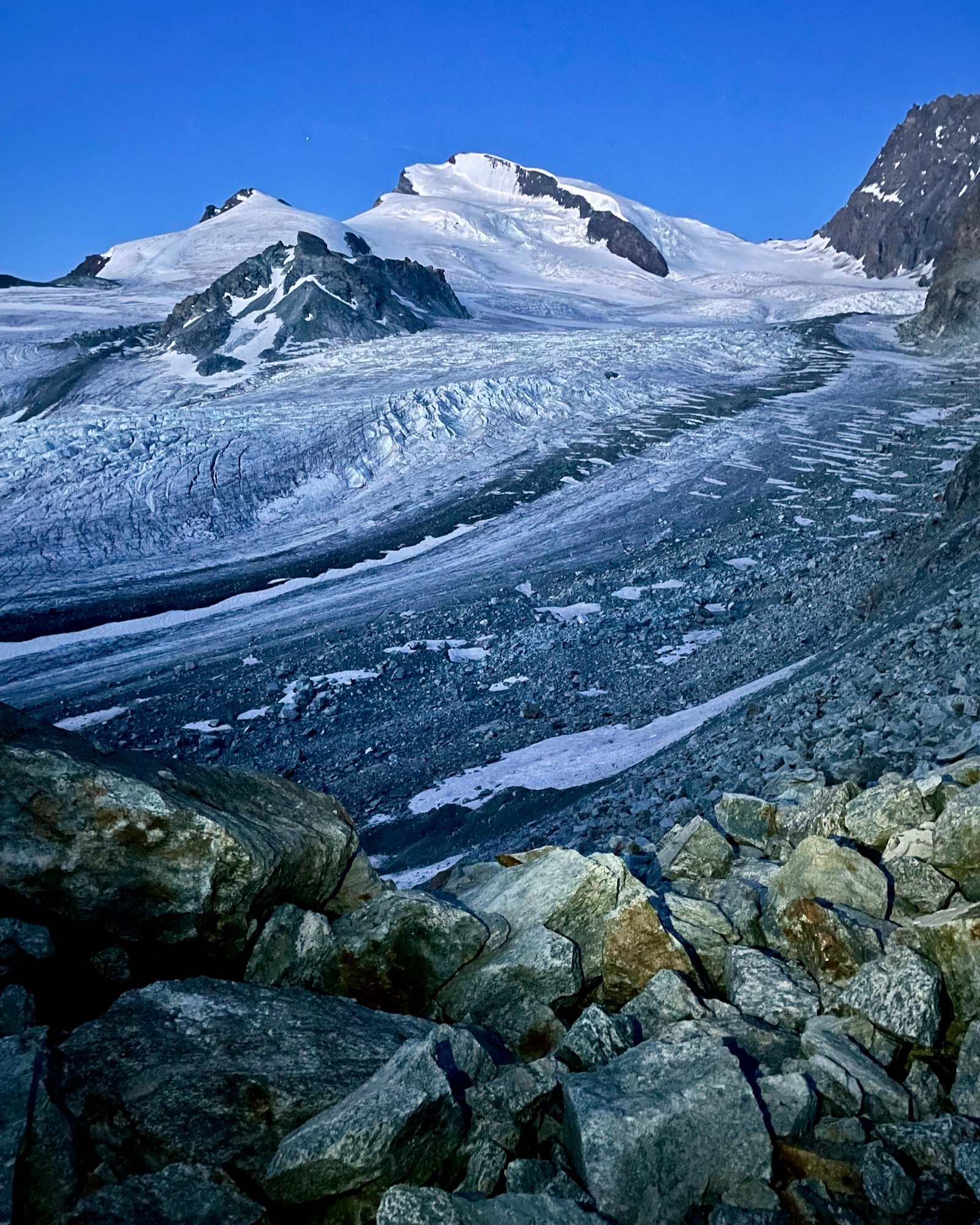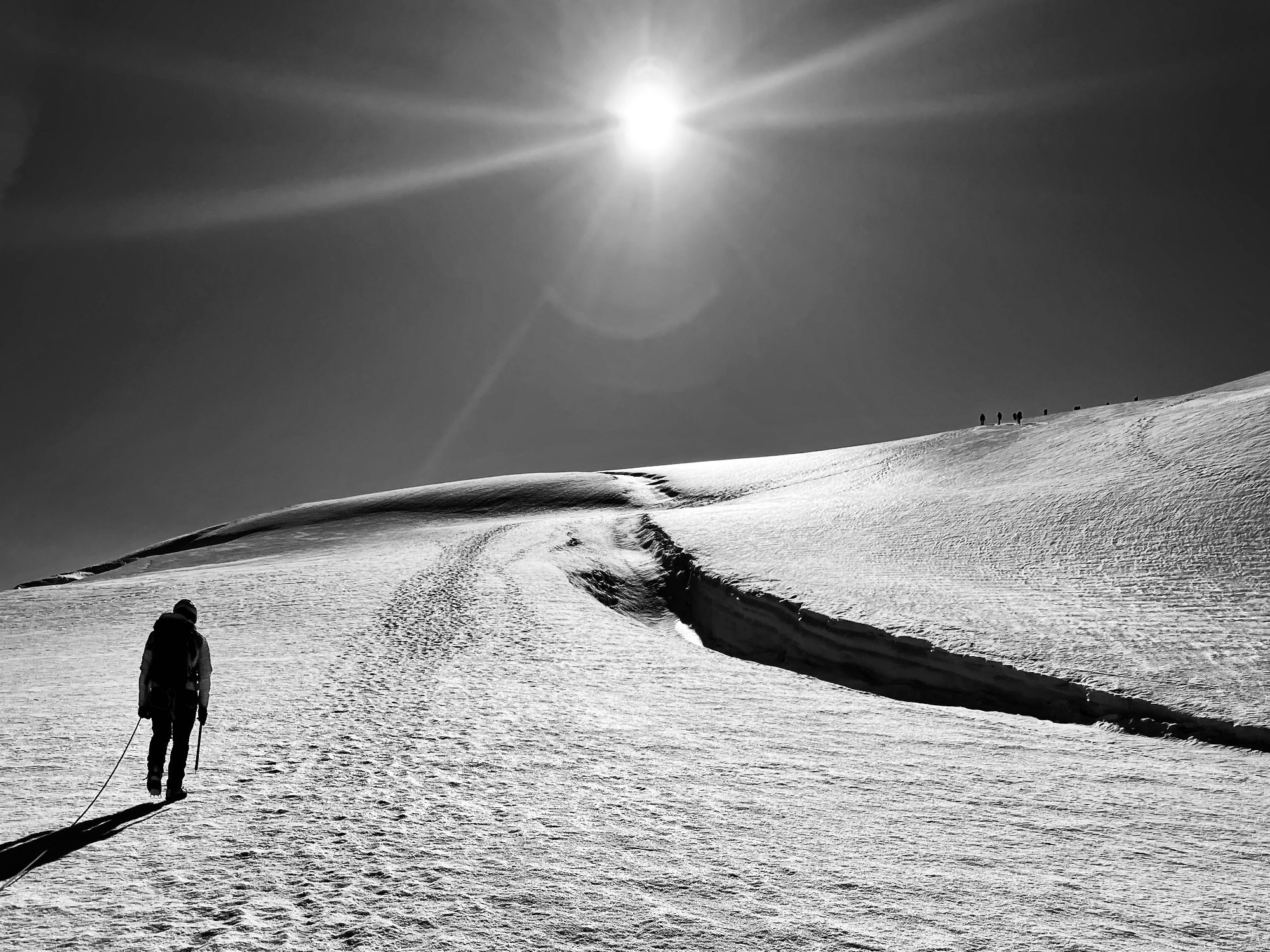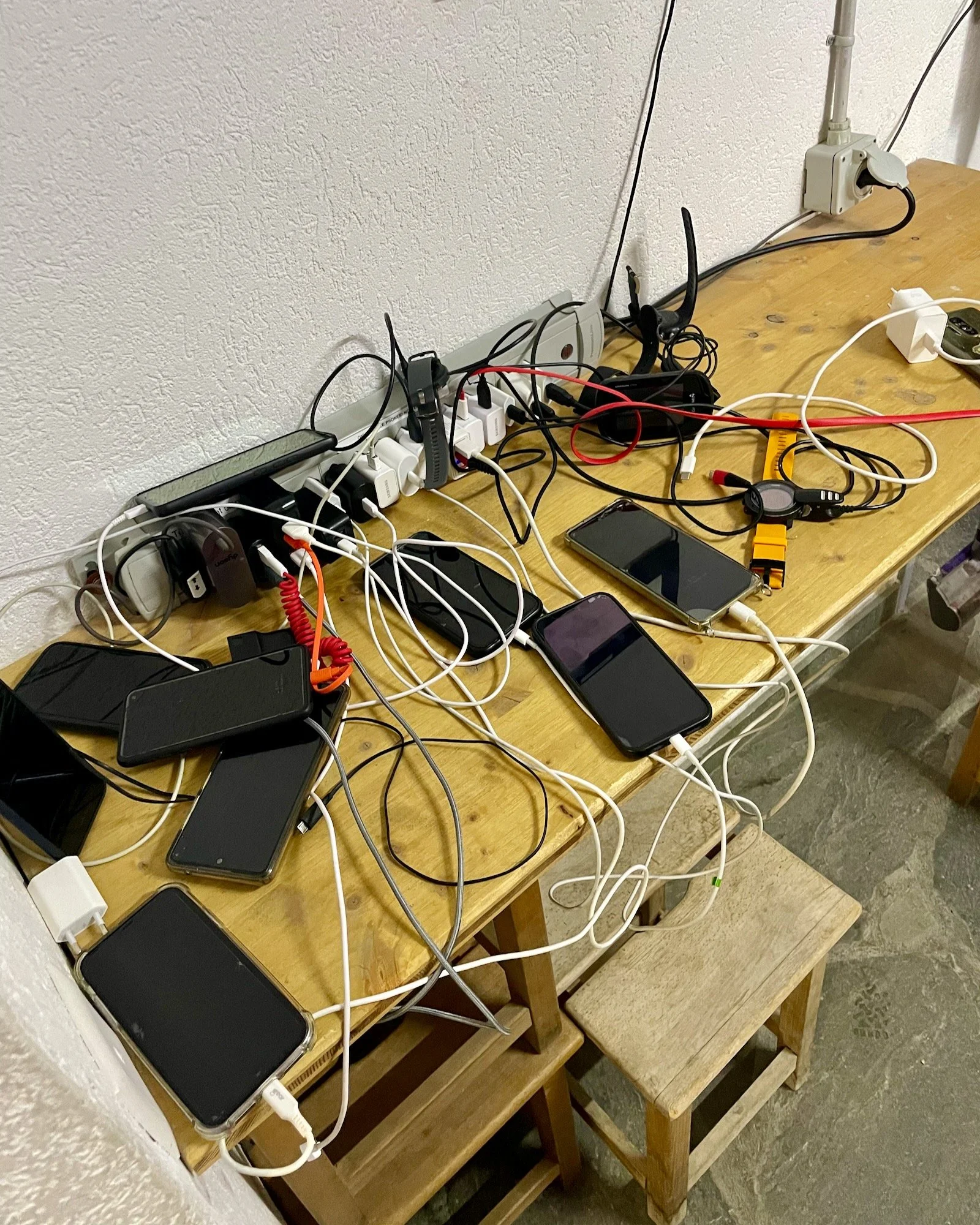Pennine Lines w/c 24 July 2023
|| Wet and cool || A premium British summer ||
Final steps to the Strahlhorn summit || Unknown climbers
|| Focus on…. ||
Phones
This week’s email comes to you directly from a very tired individual just returned from the Swiss Alps. A good week was had enjoying the spectacular scenery, good company, and mountain hut hospitality. We’re talking early getups and a couple of long glacier plods, and a couple of even longer road journeys. So if this is riddled with typos forgive me.
For reference, once you take a few stops for naps, coffees and food then Sheffield-to-Visp takes about 24hours on the road in a van, with the last few hours seeming to extend off to infinity, requiring significant belief that you’ll make it there at all. We were forced to resort to the secret weapon to power us through the final leg of the drive - the 1977 Meat Loaf album “Bat Out Of Hell”. Thankfully the journey is not as bad on the way home as you cover the slowest terrain first, but still it’s a long way. If I close my eyes I’m pretty sure I can still see the empty visual monotony of the French peage motorways flashing before my eyes like some kind of late 1990s Windows screensaver.
Afternoon recovery at 2886m || Bordier Hut
I’ve not been to the Alps for a few years, and one unexpected bonus of Britain’s political shambles of recent years combined with spiralling cost of living and rampant corporate profiteering here at home means that Switzerland now barely feels any more expensive than the UK. Certainly when you collapse into a remote mountain hut at then end of an exhaustingly nerve-wracking 10-hours dodging crevasses on a melting glacier and order a pint of helicopter-supplied Swiss lager for 7 francs (about £6.30) then that starts to look like astonishingly good value compared to the average UK town centre pub. Plus a single pint goes a long way when you’re a bit dehydrated at a heady 3000 metres above sea level, if you get my drift.
Anyway, as we established last week the Swiss Valais Alps is legit content for Pennine Lines in times of extremis. So I’m playing that card again this week (hopefully the last time for a while, assuming it doesn’t rain all this week). And with a complete switch in visual style too - while last week was all film shots, this time I’m going entirely with phone images (iPhone 12 Mini to be exact, for all the geeks out there).
Strahlhorn and the Allalin Glacier at dawn || Valais Alps
Having carted a fairly big camera around the Alps on previous trips I decided to go minimal and lightweight this time. So I took an Olympus XA4 compact 35mm camera, just about the lightest and most foolproof camera imaginable. However, in line with the delayed gratification ethos of film I’ve not developed those images yet, so those future masterpieces (or cockups) will have to wait. Instead I’ll take this as an opportunity to see how modern phone images hold up for mountain photography.
Firstly, the obvious win for phones as an image making tool is in immediacy and accessibility. As the saying goes the best camera in the world is the one you have with you. Even if you’re away in the mountains with no phone signal you’ve probably got the phone with you anyway, and in fact if you’re trying to carry as little as possible then the phone which you’re already carrying anyway becomes a sort of freebie camera in terms of weight. You can shop around all you want for the lightest ‘proper’ camera but it’s hard to beat zero grams.
Approaching the upper reaches of the Strahlhorn || Climbers unknown
Secondly, as people have been saying for years, the quality of phone cameras has gotten better and better all the time, and many would contend you don’t even need a ‘proper’ camera anymore to produce what you could refer to as publishable results. Well, this is sort of true and sort of completely untrue, depending on the context. Certainly the overall look and tonality of iPhone images has massively improved in recent years, and with some pretty smart processing under-the-hood they handle extremes of contrast and poor light incredibly well. Basically you can pretty much point a phone at anything now as you’ll get something reasonably sharp with good tonality and not have to think too much about it. Bright white snow against black rock? Not a problem. Shooting directly into the sun? No problem if you keep the lens clean.
I even managed sharp handheld images at very slow shutter speeds in the pre-dawn light of the early hours of the morning without any trouble; I was genuinely impressed. And the seamless stitching of the swing-panorama has been a strongpoint of iPhones for many years now, and can definitely be employed in the mountains for significant impact as long as you can muster a scene that can do it justice and fill the frame (not usually a problem in the Alps!).
Lost in space on the Strahlhorn || Swiss Valais
Also, considering the main target usage for phone shots - social media and viewing on phones/iPad screens etc - then the detail is great. However, it’s when you view the images up close, or compare them with shots from a ‘proper’ camera of similar resolution you sort of see the fine detail just isn’t there and tends to look very heavily processed. Which is fine for on-screen use, and probably looks OK if printed to an appropriate size, you just have to know the limitations of the files. You also have to understand that phones have fixed lenses, so if and when you ‘zoom’ you’re just cropping in and hence losing resolution. So your best option for quality is to stick with shooting at whatever the native non-zoomed focal length is. A genuine long-lens option is the most gaping missing piece of the phone-as-mountain-camera solution though, which is a shame.
The iPhones which now come with multiple lenses do a decent job of managing to make the transition between super-wide and wide lenses seamless, but it’s worth learning how to keep the phone camera set to the ‘normal’ lens and not the ultra-wide lens, as the latter usually actually look pretty crap and will give you a weird stretched look in the periphery of the image if you’re not careful. Maybe fine for getting all your newly acquainted alpine mates in shot around the dinner table in the hut but I’d pass on it for any time you want to maximise image quality.
Hikers approaching the Britannia Hut from the Egginer || Saas Fee, Swiss Alps
There’s a few things you need to know about when using phones in the mountains though, because it’s not all gravy. The worst part of using phones as cameras, for my money, is the physical handling. It’s usually impossible to unlock the phone or access the camera app whilst wearing gloves, so if you’re already in a really cold and windy situation up on some summit or other that might tip the balance towards not bothering to try and get a photo, or getting very cold hands if you do. Also phones are easy to drop if you have cold or damp hands, or gloves on, or the slippy remnants of that suncream all over your hands. And they are relatively fragile - in fact despite being in my pocket I still managed to crack my screen protector whilst scrambling last week.
We should not overlook the issue of power too. Many modern mirrorless cameras are also no better for this than phones, but you do have to remember that you may struggle to make it through the day with your phone if you’re also using it for maps and navigation as well as photos. So then you’re looking at carrying power banks, or solar panels, or simply trying to jockey for space at the charging station that many mountain huts are now providing (including playing the “does this USB port actually work or has my cable gone funny?” lottery). Needless to say my XA4 manages fine with a few spare rolls of film chucked in my bag and a pair of little button batteries that last years.
Charging chaos at 3030m || Britannia Hut
The other main problem is viewing the screen. Even with a nice iPhone with a great screen turned up to max brightness, if you’re trying to use it in the blazing rarified sunlight of an alpine summer’s day at high elevation then you are not going to be able to see that screen. So you’re left with pure guesswork - ironically a very film-like problem! I even accidentally took a flattering closeup photo of my own face instead of the distant view because I couldn’t even tell the front-facing camera was enabled. Yes you could drape your hat or jacket over the screen and pretend it’s a large format camera but you’re also tied to your friend who’s probably keen to crack on back down the mountain before the glacier completely melts so bear in mind all faffing around like this is going to get very old very quickly. Basically you can’t really beat a ‘proper’ camera’s viewfinder in bright light.
Anyway, as I hope these photos prove a decent iPhone or similar are very capable in the mountains if you don’t need to peer into the fine details too closely. Like anything you just need to understand the limitations of the tools you’re working with, but I’d not let them put you off, as long as you can find a way to see the screen.
View from the Balfrin across the Ried Glacier to the Nadelgrat || Swiss Valais
|| SUPPORTED BY ||
|| Crag Cleanup ||
Once again Outside in Hathersage are organising a Crag Clean-Up day in August, a date for your diary and a very worthy endeavour to support.
|| Recently Through the lens ||
More from around the Bordier and Britannia huts
|| Fresh Prints ||
I will be the first to admit the UK weather this July has been terrible, making the prospect of just hunkering down for some training an appealing prospect - find some psyche in the Print Shop.













